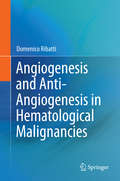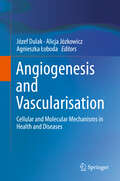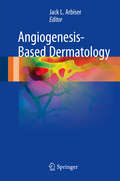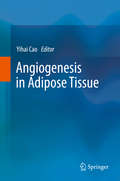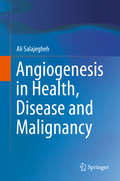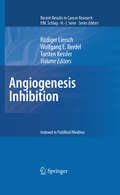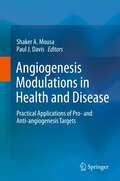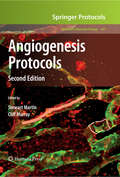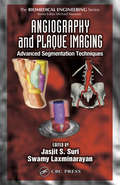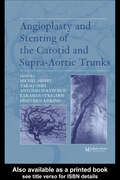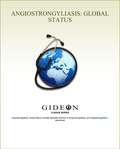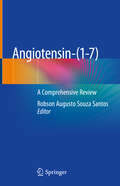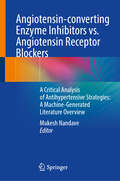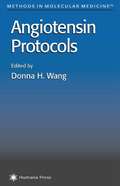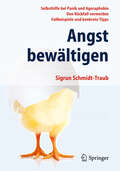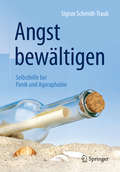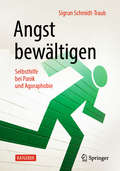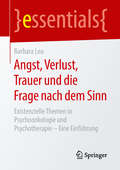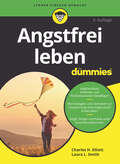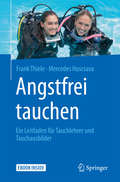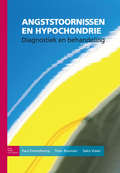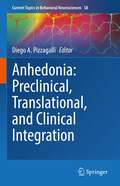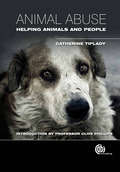- Table View
- List View
Angiogenesis: From Basic Science to Clinical Applications
by Napoleone FerraraWhy a new book on angiogenesis and why now? For the first time concepts proposed over 30 years ago have found clinical validation. In the last two years the first antiangiogenic agents have been approved by the FDA for the treatment of cancer and age-related macular degeneration. Not surprisingly, this clinical success has raised a new set of basic
Angiogenesis and Anti-Angiogenesis in Hematological Malignancies
by Domenico RibattiIt has been generally accepted that angiogenesis is involved in the pathogenesis of hematological malignancies, like acute and chronic leukemia, lymphoma, myelodysplastic syndromes, myeloproliferative neoplasms and multiple myeloma. The extent of angiogenesis in the bone marrow has been correlated with disease burden, prognosis and treatment outcome. Reciprocal positive and negative interactions between tumor cells and bone marrow stromal cells, namely hematopoietic stem cells, fibroblasts, osteoblasts/osteoclasts, endothelial cells, endothelial progenitor cells, T cells, macrophages and mast cells, mediated by an array of cytokines, receptors and adhesion molecules, modulate the angiogenic response in hematological tumors. More recently, it has been emphasized the pro-angiogenic role of the so called "vascular niche", indicating a site rich in blood vessels where endothelial cells and mural cells such as pericytes and smooth muscle cells create a microenvironment that affects the behavior of several stem and progenitor cells, in hematological malignancies.
Angiogenesis and Vascularisation: Cellular and Molecular Mechanisms in Health and Diseases
by Józef Dulak Alicja Józkowicz Agnieszka ŁobodaThe book presents the overview of the current knowledge in some fields of vascular biology, addressing cellular and molecular aspects of blood-vessel formation and their role in health and disease. The major factors involved in the formation of blood vessels are presented by scientists actively involved in this area of research. Special emphasis is put on the presentation of various molecular mechanisms not addressed in similar works to date. The book is divided into three parts. The first part describes the cells and mediators in angiogenesis. The significance of various populations of potential endothelial progenitors is particularly highlighted. The chapters of the second part focus on molecular mechanisms, with special emphasis on the role of hypoxia, gasotransmitters and reactive oxygen species as well as microRNAs in regulation of angiogenic processes. In the third part, the pathological aspects of disturbed - aggravated or impaired - vascularization are discussed and new modalities for potential therapies are presented. The book is intended for scientists and PhD students in the fields of vascular biology and cancer research. It may be of interest for medical professionals in the fields of cardiovascular disease, diabetes, oncology and rheumatoid arthritis.
Angiogenesis-Based Dermatology
by Jack L. ArbiserThis book provides a complete overview of all aspects of angiogenesis in dermatology. This is a guide to the principles of angiogenesis that will allow all involved in dermatology from the medical student and nurse practitioner to the experienced dermatologist to apply these principles for the treatment of patients. <P><P> Angiogenesis is a principle that can be used to guide treatment of diseases of any organ system. Dermatology may be the first specialty to be guided by the principle of angiogenesis because the lesions are visible and response can be easily monitored. Dermatologists already inhibit angiogenesis as part of their treatment of multiple common dermatologic disorders, including acne, warts, and nonmelanoma skin cancer.
Angiogenesis in Adipose Tissue
by Yihai CaoAngiogenesis has recently played a critical role in regulation of adipose tissue expansion and regression. Like most other tissues in the body, adipose expansion and regression is accompanied by alteration of blood vessel density and structures. The vascular alteration plays an active role in regulation of adipose tissue size and functions. Targeting blood vessels in the adipose tissue have demonstrated to be a novel approach for possibly treatment of cancer, obesity and other metabolic diseases. This book provides the most updated information on this type research and discusses future opportunities for therapy..
Angiogenesis in Health, Disease and Malignancy
by Ali SalajeghehThis book is about "Angiogenesis". A process in which new vasculature is formed from pre-existing capillaries. Angiogenesis process is associated with the proliferation and growth of both physiologically normal and neoplastic tissues, through the formation of vascular supply, essential for delivering growth requirements such as oxygen and nutrients. The book describes more than 100 genes and their key regulatory functions in the context of normal healthy condition, disease and malignancy, cancer proliferation and progression. New insights into the role of angiogenesis and the therapeutic inhibition of its regulators are investigated, due to the great potential for exploitation in the development of a novel treatment for cancer. New scientists, junior researchers and biomedical science students will find this book an invaluable introductory reference to their insight about angiogenesis and angiogenic role of more than 100 angiogenes and their role in healthy, disease and malignant conditions.
Angiogenesis Inhibition (Recent Results in Cancer Research #180)
by Torsten Kessler Wolfgang E. Berdel Rüdiger LierschAngiogenesis is attracting increased scientific and clinical interest. The identification of novel mediators and targeting molecules has led to significant progress in our understanding of tumor angiogenesis and tumor vessel targeting. Important advances in cancer treatment have already emerged, and in the future, blood vessel targeting will play a significant role within individualized therapeutic strategies. This volume provides a general overview of the latest developments in angiogenesis inhibition in cancer. All aspects from the bench to the bedside are considered, with detailed attention both to basic research and to its translation into clinical practice. Individual chapters are devoted to the roles of angiopoietins, HIF-1a, chemokines, PDGF and VEGF, and vascular integrins. The latest results of clinical trials are presented, and various advanced targeting strategies are discussed. This book will be invaluable to all who wish to learn of the most recent advances in this exciting field.
Angiogenesis Modulations in Health and Disease: Practical Applications of Pro- and Anti-angiogenesis Targets
by Shaker A. Mousa Paul J. DavisThis book is a major update of novel targets in angiogenesis modulation, including pro- and anti-angiogenesis. There is in-depth coverage of preclinical and clinical methods and models, investigational status, and clinical applications. The impact of nanotechnology in advancing the applications of pro-and anti-angiogenesis strategies is also highlighted, along with stem cell and biotechnologies in research and development of angiogenesis modulating targets.
Angiogenesis Protocols (Methods in Molecular Biology #467)
by Cliff Murray Stewart MartinAs experimentation and clinical trials with first generation anti-angiogenic agents have yielded results and our understanding of the biology and physiology of blood and lymphatic vessels has increased, a new angiogenesis volume swiftly became a necessity. Angiogenesis Protocols, Second Edition remains true to its original vision of providing a single source for angiogenesis researchers, irrespective of levels of resource and expertise, by collecting a range of methods for cell isolation and assessing angiogenesis in vivo or in vitro. This information, however, is expanded to include chapters on circulating endothelial progenitor cells, angiogenic signalling pathways, imaging of angiogenesis, and measurement of tissue blood flow. Written in the Methods in Molecular BiologyTM series format, the chapters provide step-by-step laboratory protocols, lists of necessary materials and reagents, and a Notes section, which details tips on troubleshooting and avoiding known pitfalls. Extensive and cutting-edge, Angiogenesis Protocols, Second Edition is not only a practical handbook for key techniques, but also an informative and enjoyable read for all those interested, no matter how directly, in angiogenesis.
Angiography and Plaque Imaging: Advanced Segmentation Techniques (Biomedical Engineering Ser.)
by Jasjit S. Suri Swamy LaxminarayanRecent, rapid advances in mathematical engineering and applied mathematics have opened the door to solving complex problems in angiography imaging. For the first time, this book presents the different medical imaging modalities--MR, CT, x-ray, and ultrasound--for performing angiography and its analysis. Pioneers from a variety of relevant disciplin
Angioplasty and Stenting of Carotid and Supra-aortic Trunks
by Michel Henry Chief Patron Takao Ohki Antonio Polydorou Kyriakos Strigaris Dimitrios KiskinisAlthough carotid endarectomy (CEA) has long been considered the gold standard technique, recent studies report that short- and long-term results with carotid angioplasty and stenting(CAS) are comparable to those with CEA in a significant number of cases. Covering clinical assessment, techniques and devices, medical treatment, and more, Angioplasty
Angiostrongyliasis: Global Status 2010 edition
by Gideon Informatics Dr Stephen BergerAngiostrongyliasis: Global Status is one in a series of GIDEON ebooks which summarize the status of individual infectious diseases, in every country of the world. Data are based on the GIDEON database (www.gideononline.com) which relies on standard text books, peer-review journals, Health Ministry reports and ProMED, supplemented by an ongoing search of the medical literature. Chapters are arranged alphabetically, by country name. Each section is divided into five subsections. 1. Descriptive epidemiology 2. Summary of clinical features 3. Global status of the disease 4. Status of the disease in a specific country 5. References Angiostrongyliasis: Global Status includes separate sections on Angiostrongyliasis, and Angiostrongyliasis - abdominal.
Angiotensin-(1-7): A Comprehensive Review
by Robson Augusto Souza SantosThis is the first book addressing in full the most important aspects of the angiotensin-(1-7), the key peptide of the protective axis and the main component in the new modulatory concept of the renin-angiotensin system. It features a detailed review of angiotensin-(1-7) and its receptor Mas, comprising the historical background, enzymatic pathways for generation, functions, integrative aspects of its protective profile, and its therapeutic potential. It also encompasses a comprehensive presentation of current knowledge about its widespread biological actions on several tissues, as well as the most recent scientific achievements, emerging from preclinical and clinical trials. Dr. Santos is a renowned researcher on the Renin-Angiontensin system, with remarkable achievements regarding the role of peptides such as alamandine and angiontensin-(1-7). He has also worked on the potential clinical applicability of angiotensin-(1-7)-related drugs for cardiovascular diseases. He has an extensive publication record in the field, including the publication of the book The Protective Arm of the Renin Angiotensin System (Academic Press, 2015).Angiotensin-(1-7) will make a unique contribution to the literature and will be an important resource for biomedical students and researchers, medical practitioners and any other professional interested in this peptide and its role in the renin-angiotensin system.
Angiotensin-converting Enzyme Inhibitors vs. Angiotensin Receptor Blockers: A Critical Analysis of Antihypertensive Strategies: A Machine-Generated Literature Overview
by Mukesh NandaveThis book delves into the various aspects of the renin-angiotensin-aldosterone system (RAAS) and its role in cardiovascular disorders. It explores the use of anti-hypertensive agents, with a focus on (ACE) angiotensin-converting enzyme inhibitors and angiotensin receptor blockers (ARBs). The chapters cover topics such as the preferred use of ACE inhibitors over ARBs in high-risk patients, the impact of these agents on insulin resistance, their role in acute heart failure and peripheral artery disease, and their immunomodulatory activity in hypertensive patients. Additionally, the book examines the role of ACE inhibitors and ARBs in COVID-19 patients and provides insights into recent trends in managing hypertension through RAAS inhibition. It serves as a valuable resource for researchers, clinicians, and healthcare professionals involved in the field of cardiovascular medicine.
Angiotensin Protocols (Methods in Molecular Medicine #51)
by Donna H. WangDonna Wang and a panel of hands-on experts describe in step-by-step detail all the major molecular, biochemical, and functional techniques now used in probing the renin-angiotensin system. These range from the use of embryonic gene targeting to create of mutant strains, to the functional investigation of components of the renin-angiotensin system. Comprehensive and highly practical, Angiotensin Protocols translates expert knowledge into readily reproducible methods that enable all biomedical investigators successfully to explore the role of angiotensin in health and disease today.
Angst bewältigen: Selbsthilfe bei Panik und Agoraphobie - Den Rückfall vermeiden - Fallbeispiele und konkrete Tipps
by Sigrun Schmidt-TraubAngst und Panik bewältigen Panikartige Ängste sind enorm verbreitet. Die Angstzustände sind verbunden mit meist heftigen körperlichen Reaktionen, wie Schwindel, Herzklopfen oder Schweißausbrüchen. Sie quälen und schränken Betroffene zusehends ein. Angstpatientinnen und -patienten bringen im Laufe der Zeit immer mehr Situationen mit ihren Angstzuständen in Verbindung und vermeiden sie. Ein Teufelskreis, der sich aber mit Hilfe verhaltenstherapeutischen Wissens und Trainings auflösen lässt. Den Teufelskreis aus Angst und Vermeidung durchbrechen Der Ratgeber ist von einer erfahrenen Therapeutin verständlich und motivierend geschrieben. Fallbeispiele zeigen Möglichkeiten auf, Panikattacken besser in den Griff zu bekommen. Gut strukturiert und übersichtlich - mit vielen Beispielen; wichtige Inhalte und Tipps sind hervorgehoben. Serviceteil: Weiterführende Literatur, Informationen zu Therapiesuche und -finanzierung, Selbsthilfegruppen etc. Sich informieren und der Angst das Angsterregende nehmen Der Ratgeber leitet zur Selbsthilfe an und gibt Tipps, an wen man sich wenden kann, wenn man sich Selbsthilfe nicht zutraut oder wenn man Unterstützung in Selbsthilfegruppen sucht.
Angst bewältigen: Selbsthilfe bei Panik und Agoraphobie
by Sigrun Schmidt-TraubDieser Ratgeber hilft Betroffenen, den Teufelskreis aus Angst und Vermeidung zu durchbrechen - er leitet zur Selbsthilfe an und gibt Tipps, an wen man sich wenden kann, wenn man sich Selbsthilfe nicht zutraut oder wenn man Unterst#65533;tzung in Selbsthilfegruppen sucht. Panikartige #65533;ngste sind enorm verbreitet. Die Angstzust#65533;nde sind verbunden mit meist heftigen k#65533;rperlichen Reaktionen wie Schwindel, Herzklopfen oder Schwei#65533;ausbr#65533;chen. Sie qu#65533;len und schr#65533;nken Betroffene zusehends ein. Angstpatientinnen und -patienten bringen im Laufe der Zeit immer mehr Situationen mit ihren Angstzust#65533;nden in Verbindung und vermeiden sie. Ein Teufelskreis, der sich aber mit Hilfe verhaltenstherapeutischen Wissens und Trainings aufl#65533;sen l#65533;sst. Der Ratgeber ist von einer erfahrenen Therapeutin verst#65533;ndlich und motivierend geschrieben. Fallbeispiele zeigen M#65533;glichkeiten auf, Panikattacken besser in den Griff zu bekommen. Gut strukturiert und #65533;bersichtlich - mit vielen Beispielen; wichtige Inhalte und Tipps sind hervorgehoben.
Angst bewältigen: Selbsthilfe bei Panik und Agoraphobie
by Sigrun Schmidt-TraubDieser Ratgeber hilft Betroffenen, den Teufelskreis aus Angst und Vermeidung zu durchbrechen – er leitet zur Selbsthilfe an und gibt Tipps, an wen man sich wenden kann, wenn man sich Selbsthilfe nicht zutraut oder wenn man Unterstützung in Selbsthilfegruppen sucht. Panikartige Ängste sind enorm verbreitet. Die Angstzustände sind verbunden mit meist heftigen körperlichen Reaktionen wie Schwindel, Herzklopfen oder Schweißausbrüchen. Sie quälen und schränken Betroffene zusehends ein. Angstpatientinnen und -patienten bringen im Laufe der Zeit immer mehr Situationen mit ihren Angstzuständen in Verbindung und vermeiden sie. Ein Teufelskreis, der sich aber mit Hilfe verhaltenstherapeutischen Wissens und Trainings auflösen lässt. Der Ratgeber ist von einer erfahrenen Therapeutin verständlich und motivierend geschrieben. Fallbeispiele zeigen Möglichkeiten auf, Panikattacken besser in den Griff zu bekommen. Gut strukturiert und übersichtlich – mit vielen Beispielen; wichtige Inhalte und Tipps sind hervorgehoben. Aus dem Inhalt: Zum Verständnis von Angst – Bewältigung der Angst – Materialien zur Selbsthilfe. Die Autorin:Dr. Sigrun Schmidt-Traub, Diplom-Psychologin und -Soziologin, Verhaltenstherapeutin für Kinder, Jugendliche und Erwachsene mit über 30-jähriger ambulanter Erfahrung in eigener Praxis. Heute in der Ausbildung von angehenden Verhaltenstherapeuten als Dozentin und Supervisorin tätig. Verfasserin von zahlreichen Selbsthilfe- und Lehrbüchern zum Thema Angststörungen.
Angst, Verlust, Trauer und die Frage nach dem Sinn: Existenzielle Themen In Psychoonkologie Und Psychotherapie - Eine Einführung (Essentials)
by Barbara LeuEine Krebsdiagnose wirft die meisten Menschen aus der Bahn und bedeutet einen tiefen und bedrohlichen Einschnitt in ihr eigenes Leben, aber auch dasjenige ihrer Angehörigen. Die Erkenntnis, dass das Leben endlich und prekär ist, kann existenzielle Ängste, tiefe Trauer und Fragen nach dem Sinn auslösen, geht es ja letztlich um die Fragen nach Sterben und Tod. Wie können involvierte Fachpersonen mit diesen letzten Fragen der „conditio humana“ umgehen, wie können sie, trotz eigener Betroffenheit, angesichts dieser existenziellen Herausforderungen tragend und hilfreich sein? Diesen Fragen geht die vorliegende Publikation mit theoretischen Inputs sowie praktischen Vorschlägen für den Aufbau einer existenziellen Grundhaltung erfolgreich nach.Die Autorin Barbara Leu ist Psychotherapeutin (systemisch und existenzielle Ausrichtung) und Psychoonkologin am Kantonsspital Aarau, Schweiz. Daneben arbeitet sie als Psychotherapeutin in einer psychiatrisch/psychologischen Gemeinschaftspraxis in Zürich, Schweiz.
Angstfrei leben für Dummies (Für Dummies)
by Charles H. Elliott Laura L. SmithViele Menschen leiden unter à ngsten - sei es Platzangst, Flugangst, Angst vor Zurückweisung, Angst vor dem Verlust des Partners oder Kindes oder Angst vor dem Verlust des Arbeitsplatzes. So unterschiedlich diese à ngste sind, eines haben sie gemeinsam: Sie beeinträchtigen das Leben der Betroffenen und ihrer Angehörigen enorm. »Angstfrei leben für Dummies« hilft mit Selbsttests und einfachen à bungen, einen Weg aus dem Teufelskreis von Angst und Sorgen zu finden. Dieser Ratgeber zeigt, wie Sie Ihren à ngsten Schritt für Schritt begegnen können und wie Sie sie schlieà lich überwinden und sich nicht mehr von ihnen beherrschen lassen.
Angstfrei tauchen: Ein Leitfaden für Tauchlehrer und Tauchausbilder
by Frank Thiele Mercedes HuscsavaPanik unter Wasser? Ein Alptraum f#65533;r Tauchsch#65533;ler und Tauchlehrer. Damit dies nicht geschieht, liefert das vorliegende Buch Tauchlehrern und Tauchausbildern wertvolle Informationen, wie man Stress oder #65533;ngsten bei Tauchsch#65533;lern erfolgreich begegnet. Die Autoren erl#65533;utern das menschliche Verhalten dabei sowohl aus wissenschaftlicher Sicht, also ,,Warum haben wir Angst?", oder ,,Wie entsteht Angst #65533;berhaupt?" und geben gleichzeitig zahlreiche Tipps, die in einer Akutsituation helfen - vor oder w#65533;hrend des Tauchgangs. Auch auf die Besonderheiten beim Tauchen mit Kindern in den verschiedenen Altersgruppen geht das Werk ein.
Angststoornissen en hypochondrie: Diagnostiek en behandeling
by P. M. G. Emmelkamp T. K. Bouman S. VisserAngststoornissen en hypochondrie is een actueel overzichtswerk, waarin op praktische wijze inzicht gegeven wordt in de classificatie (volgens de DSM-IV-TR-criteria), diagnostiek, etiologie en behandeling van angststoornissen en hypochondrie. Bij de behandeling van deze stoornissen wordt, naast een bespreking van farmacotherapie, met name aandacht besteed aan recente ontwikkelingen in de cognitieve therapie en gedragstherapie. Er zijn door de jaren heen vorderingen gemaakt op het gebied van research die implicaties hebben voor de diagnostiek en behandeling van deze stoornissen. Angststoornissen en hypochondrie gaat uitvoerig in op de problemen die zich bij het uitvoeren van de behandeling kunnen voordoen. Bovendien wordt in heldere taal een genuanceerd beeld van de huidige stand van zaken in onderzoek en theorievorming weergegeven. Het boek is voorzien van gevalsbeschrijvingen. De hoofdstukken over behandeling gaan met name uit van (cognitieve) gedragstherapeutische principes vanwege de belangrijke resultaten die daarmee geboekt zijn in de behandeling van angststoornissen en hypochondrie. Daarnaast wordt per stoornis steeds een overzicht geboden van recent onderzoek naar de behandeling met psychofarmaca. Angststoornissen en hypochondrie is een geheel herziene en geactualiseerde druk van het boek Angst, fobieën en dwang. Angststoornissen en hypochondrie is bedoeld voor psychologen, psychiaters, huisartsen, maatschappelijk werkenden en opleidingen voor deze beroepen.
Anhedonia: Preclinical, Translational, and Clinical Integration (Current Topics in Behavioral Neurosciences #58)
by Diego A. PizzagalliAnhedonia is a key symptom (and often risk factor) for various neuropsychiatric disorders, including depression, schizophrenia, substance use disorders, post-traumatic stress disorders, and Parkinson's Disease, among others. Across disorders, anhedonia has been associated with worse disease course, including poor response to pharmacological, psychological and neurostimulation treatments as well as completed suicide. Mounting evidence emerging from preclinical and translational sciences has clarified that "anhedonia" can be parsed into partially independent subcomponents, including incentive motivation, consummatory pleasure, reward learning, and effort-based decision making, pointing to distinct neurobiological substrates that could underlie anhedonic phenotypes. Taking an integrative approach that emphasizes cross-species integration and dimensional conceptualization of mental illnesses (e.g., Research Domain Criteria (RDoC)), this book represents the most comprehensive evaluation, synthesis and integration of theories and empirical findings focused on anhedonia.Organized across five parts, the handbook starts with chapters on the history, etiology, and assessments of anhedonia (Part I), followed by a section on the role of anhedonia in psychiatric and neurological disorders (Part II). Using the RDoC Matrix as a guide, Part III presents chapters synthetizing preclinical and clinical findings on different reward processing subdomains (e.g., reward responsiveness, reward valuation, reward learning). Part IV is focused on selected special topics, including historical and current perspectives on the transdiagnostic nature and importance of social anhedonia, the role of inflammation in the pathophysiology of anhedonia, the use of computational modeling to “dissect” anhedonia and improve its understanding, and links between anhedonia and suicide. Finally, Part V includes chapters on pharmacological, psychological and neurostimulation treatments for anhedonia.
Animal Abuse
by Catherine TipladyAnimal abuse affects everybody working in animal-related industries, and constitutes a significant part of veterinary caseloads and animal shelter work. Based on the author's experience as a shelter worker and veterinarian, this book provides advice and assistance to those working with animal abuse. Beginning with definitions and types of abuse that occur worldwide in domestic, industry, leisure and cultural settings, the book goes on to detail current topics of debate such as foie gras production, pedigree dog breeding, links between animal abuse and domestic violence, and the fascinating subject of veterinary forensics - the scientific investigation of instances of animal abuse. The book's practical focus is developed through interviews with people in a variety of affected roles, international case studies, and discussion of the difficulties that arise; how they can be dealt with and the mental health impacts they can have on those involved. With contributions from world-renowned experts including Phil Arkow and David Bailey, and an introduction by Clive Phillips, Animal Abuse: Helping Animals and People provides practical advice and insights into issues surrounding this emotional subject.
Animal Abuse: Helping Animals and People
by Catherine TipladyAnimal abuse affects everybody working in animal-related industries, and constitutes a significant part of veterinary caseloads and animal shelter work. Based on the author's experience as a shelter worker and veterinarian, this book provides advice and assistance to those working with animal abuse. Beginning with definitions and types of abuse that occur worldwide in domestic, industry, leisure and cultural settings, the book goes on to detail current topics of debate such as foie gras production, pedigree dog breeding, links between animal abuse and domestic violence, and the fascinating subject of veterinary forensics - the scientific investigation of instances of animal abuse. The book's practical focus is developed through interviews with people in a variety of affected roles, international case studies, and discussion of the difficulties that arise; how they can be dealt with and the mental health impacts they can have on those involved. With contributions from world-renowned experts including Phil Arkow and David Bailey, and an introduction by Clive Phillips, Animal Abuse: Helping Animals and People provides practical advice and insights into issues surrounding this emotional subject.

